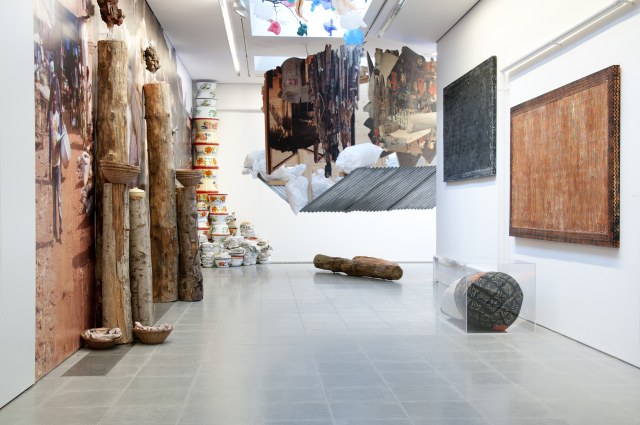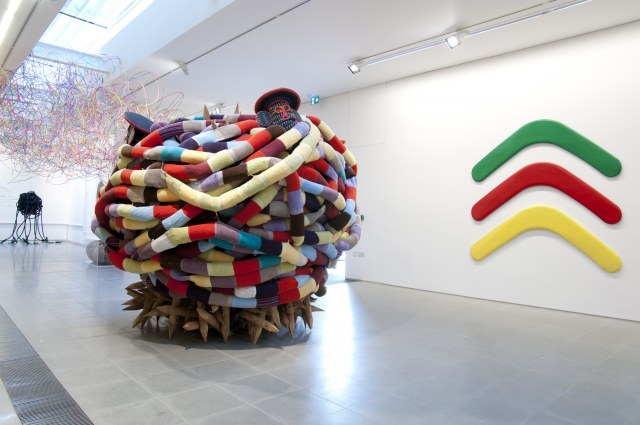
He makes new works with things he can put his hands on while he is there, works that were standing in one show are hanging from the ceiling in the next one, stones he gave a bright color in a narrow street in Siena are transformed into a pile of colored stones in London. He is not only recycling objects, fabrics, things, he also recycles his own works. So, working with Tayou will definitely be very inspiring, but it also is a challenge.
Rob Perrée on Pascale Marthine Tayou.
Photo: Ben Pruchnie, Getty Images.
Pascale Marthine Tayou in the Serpentine Gallery in London
“I HAVE NEVER INTENDED TO BE AN ARTIST.”
Three viewing experiences.
1.
It must have been in 1995 or 1996. I walked into a relatively small, new gallery in Chelsea. It was several levels above the ground floor. The whole space was covered with metro tickets, bus and train tickets, boarding passes for flights to various countries and receipts from restaurants, cafes, office stores and hardware stores. Oddly enough my first reaction was: I cannot walk over them. The what’s-going- on-feeling was next. I had no idea what to do with what I saw, what to think about it. On the other hand it intrigued me immensely and excited me very much. Who was behind this? The gallery owner guessed my question: “this is a young artist from Cameroon.” The Pavlov in me did not disappoint me. “I want to talk with him. Can I reach him? Is he here? “ She hesitated. “I cannot promise. We can barely reach him. He lives everywhere and nowhere.” That one little sentence explained the installation unintentionally . An African artist who portrays the African as a nomad.
2.
In 2005, I was with a friend at the Venice Biennial. Over the years I had followed the career of Pascale Tayou as much as possible. I had seen him on the list of the participating artists. There was no doubt, I had to see his work. His work was installed outside, on the edge of the water. I saw it from a distance. It was a long clothesline where dozens of colored plastic bags played a whispering and sometimes flapping game with the wind. The friend looked around, wondering about what was going on . He was looking for the work of the artist of whom I had told him many times. My enthusiasm eluded him completely. You could spoon the astonishment from his face.
Installation View, Serpentine Gallery, 2015.
3.
A few weeks ago I was in London to see some new exhibitions. One of those exhibitions was the ‘Boomerang’ show of Pascale Marthine Tayou in the Serpentine Gallery in Hyde Park. The exhibition is arranged as a kind of walkabout. It felt as if I was strolling through a festively ‘dressed’ little street in a warm country. Colorfully decorated by someone who could not possibly be an Englishman. Not neat and formal enough. That first impression I had to revise quickly when I looked more closely at the various works . Festivity turned into sometimes tough reality. Under and behind all this gaiety serious engagement showed it’s face . My first impression came back to me like a boomerang.
 Installation View, Serpentine Gallery, 2015.
Installation View, Serpentine Gallery, 2015.
4.
Pascale Marthine Tayou was born in Yaoundé, Cameroon in 1966. It was much later that he changed his first names into the female Pascale and Marthine. “That’s a way of taking position. There were not very many female artists back then. Making my first names female was a way of addressing the question.”(2) He never had an art education. He is a lawyer . “I never intended to be an artist, but I’m curious.”(1) ‘Art’ and ‘artist’, for him these words don’t mean much. “I am a maker, I make things. I’ve nothing else to do”, he says in an interview with Julie Estève (1). “To me, art does not exist, it’s we who represent it.” (1)
In order to make an international career he realized that he had to travel. Physically he left his country, but mentally he took his country with him on all his travels all the time. The success came fast – his work was presented in 5 museum shows in Japan in 1996, it was in the Documenta of 2002 and in the Venice Biennials of 2005 and 2009 – and still lasts.
 Installation View, Serpentine Gallery, 2015.
Installation View, Serpentine Gallery, 2015.
5.
Most of the time Tayou is working with existing material: things he used before, things he has found around him. Sometimes that means garbage but also things you can buy easily in a hardware store or on a flea market. It is important for him that these ‘things’ have a relation with the location where he is presenting his work, with the city he lives in – Brussels – or with memories of his childhood. They have a character already and often they have a history. Using them means making them part of an installation or a sculpture. Manipulating them in order to make them fit into a larger whole. In ‘Africonda’ (2014)he used towels. He sewed the towels together and turned them into a long colorful serpent caught in its own trap. ‘Chalks’ (2014) is wallpaper based on a messy composition of hundreds of used pieces of chalk. Most of them are white, but there are also colored ones popping up. ‘Octopus’ (2010) consists of a knot of 10 petrol tubes. Once functional, now harmless.
 Installation View, Serpentine Gallery, 2015.
Installation View, Serpentine Gallery, 2015.
Because every exhibition of Tayou is lively, almost festive, colorful, and full of funny details. They are surprising combinations and transformations, strange materials, common things used differently, recognizable memories, folklore and kitsch, provocations and contradictions, it is easy to misinterpret them . What does he want to tell us ? What is behind all of this? That is not easy to find out, because his work is about so many things . The sculpture ‘Africonda’ looks appealing, innocent and cuddly, but it symbolizes a world full of people pretending and role-playing to avoid real contact with each other . Result? They are biting their own tail. ‘Octopus’ refers to oil companies that are exploiting Africa, making money, without caring about what they cause and leave behind. Their tentacles reach far and are dangerous. ‘Plastic Tree’ (2014), the with colorful plastic bags decorated branches on the ceiling, refers to the way we disrespect our natural environment. The ‘Poupées Pascale’ (2015) look like traditional statues but by using crystal as material, Tayou, gives them an over-the-top-presence, transforms them into ourselves , people who are more interested in luxury than in tradition or history. We are challenged to replace the name Pascale with our own name. ‘Cotton Tiges’ (2015), the cloud of cotton hanging in a dark shaft, looks innocent and peaceful but the work has everything to do with slavery, with the way people treat each other, with the dominance of one person over another person . In ‘Code Noir’(2015), slender colonial figurines are bundled. Tourists buy them on local African markets or at the airport. Visitors don’t realize that the original ones where white skinned, commissioned by colonists. A 3D portrait of themselves. They are dressed like colonists but their skin is black. An ironic way of taking revenge.
 Installation View, Serpentine Gallery, 2015.
Installation View, Serpentine Gallery, 2015.
Whatever work he makes, it always shows his involvement in the world around him. “I am an observer. I point out incoherence, contradictions, problems. Then the challenge is to communicate that without falling into incontrovertible accusations and sterile arguments. It is about reflecting, and inviting people to find solutions. All these questions flicker across my control screen and I can’t just dismiss them. So I transform them into artworks. It is the only power I have as an artist.” His work may look perhaps innocent and light – a critic called it “eye candy” –but there is a tough truth in it.
 Installation View, Serpentine Gallery, 2015.
Installation View, Serpentine Gallery, 2015.
6.
In the beginning of this year Pascale Marthine Tayou had an exhibition planned in Los Angeles. Four days before the opening the crates with ‘stuff’ work had not arrived . Customs stopped them for unclear reasons. The artist decided not to wait any longer. He made a list of what he needed and together with the museum staff he went ‘shopping’. He created a completely new installation with all the found and bought materials. The day before the opening his crates arrived. He installed the original show within the improvised one. The invited visitors did not realize and couldn’t see all the drama that had taken place.
Installation View (detail), Serpentine Gallery, 2015.
This is a typical Tayou situation. Over the years he collected a storehouse full of ‘stuff’ , he makes sketches and plans as preparation for his exhibitions, but on the spot he leaves all possibilities open. He changes works at the last moment, he adds texts on the wall as a finishing touch,. He makes new works with things he can put his hands on while he is there, works that were standing in one show are hanging from the ceiling in the next one, stones he gave a bright color in a narrow street in Siena are transformed into a pile of colored stones in London. He is not only recycling objects, fabrics, things, he also recycles his own works. So, working with Tayou will definitely be very inspiring, but it also is a challenge. The catalogue that goes with ‘Boomerang’, the exhibition in the Serpentine Gallery, is a prime example of this. It was trying to reproduce the works that would be in the show, but almost none of the photos show the works as they are actually installed. It is exactly that ‘omission’ which makes it the ultimate Tayou catalogue.


